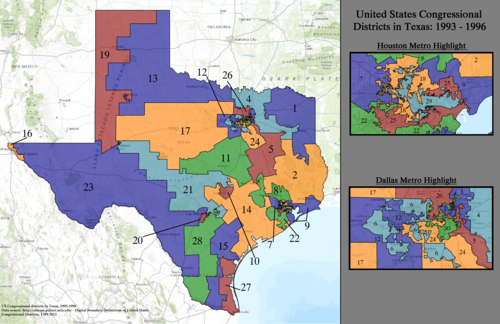
Interactive map version

A long history exists of various individuals serving in the congressional delegations from the State of Texas to the United States House of Representatives and the United States Senate, with all of this occurring after Texas as a territory was annexed as a State in December 1845.
Contents
- U.S. House of Representatives
- Current districts and representatives
- Recent historical district boundaries
- 1845 to 1863: 2 seats
- 1863 to 1873: 4 seats
- 1873 to 1883: 6 seats
- 1883 to 1893: 11 seats
- 1893 to 1903: 13 seats
- 1903 to 1913: 16 seats
- 1913 to 1933: 18 seats
- 1933 to 1953: 21 seats
- 1953 to 1963: 22 seats
- 1963 to 1973: 23 seats
- 1973 to 1983: 24 seats
- 1983 to 1993: 27 seats
- 1993 to 2003: 30 seats
- 2003 to 2013: 32 seats
- 2013 to 2023: 36 seats
- 2023 to present: 38 seats
- U.S. Senate
- Key
- See also
- References
- External links
Texas has a total of 38 seats as of 2024. The current dean of the Texas delegation is Representative Lloyd Doggett (TX-37) of the Democratic Party. He has served in the House since 1995 and is 79 years old.
Republicans have complete control of the congressional redistricting process in Texas, as any new maps are drawn and passed by the Republican-held state legislature and signed into law by the Republican governor. [3] This has resulted in Texas’ maps being a partisan gerrymander, with few competitive districts. [4] [5]






















































































